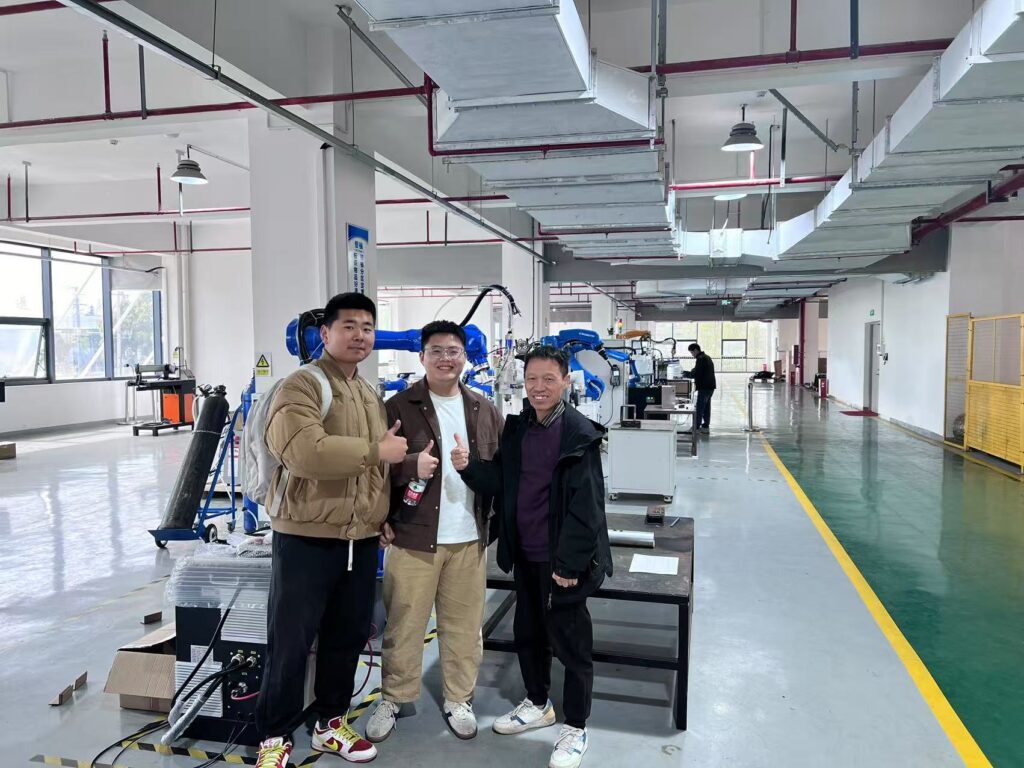“Smart factories now deploy welding robots to boost production efficiency. The global welding robotics market will reach $12.8B by 2029 (MarketsandMarkets 2023), driven by automotive giants using six-axis models for chassis assembly and electronics makers adopting laser welding cobots for micro-joints. These systems achieve 99.9% precision while reducing operator injury risks by 63% (OSHA).
What Is a Welding Robot?
A welding robot is an industrial automation system integrating 6-axis articulated arms (e.g., Fanuc M-20iD), adaptive welding torches, and real-time seam tracking sensors (e.g., SICK LMS511). Designed for precision welding operations, these systems achieve ±0.05mm repeatability (ABB technical specifications) across 20,000+ operational hours in automotive production lines.
Key Technical Capabilities
- Multi-Process Compatibility
- MIG Welding: High-speed deposition for ≥2mm steel plates (automotive frames)
- Laser Welding: 0.5μm precision for battery cell encapsulation (CATL case study)
- Spot Welding: 0.3s/cycle efficiency in white body manufacturing (Tesla Gigafactory data)
- Dynamic Path Correction
Equipped with 3D vision systems (Keyence CV-X series), robots adjust trajectories in real-time to accommodate ±2mm workpiece deformations, critical in shipbuilding applications. - Material Versatility
Processes 12+ metal types (ISO 15614 certified), including:- 0.3mm thin stainless steel (medical devices)
- 80mm thick marine-grade steel (offshore engineering)
Competitive Advantages vs. Manual Welding
| Metric | Robotic Welding | Manual Welding | Improvement |
|---|---|---|---|
| Cycle Time | ≤45s/unit | ≥120s/unit | 167% faster |
| First-Pass Yield | 99.8% (Six Sigma) | 92% | 7.8% increase |
| Consumable Cost | $0.15/m weld | $0.27/m weld | 44% reduction |
| Workplace Injuries | 0.02/1k workhours | 1.7/1k workhours | 98% safer (OSHA) |
Industry-Specific Implementations
- Automotive Manufacturing
Tesla Shanghai’s 500 KUKA robots achieve 100% automated welding on Model Y bodies, boosting output to 45 jobs per hour (JPH). - New Energy Sector
CATL’s laser welding systems ensure zero-defect battery sealing, achieving 99.95% yield in lithium-ion cell production. - Heavy Machinery
SANY Group’s 60 Yaskawa workstations enhanced structural component welding efficiency by 210%, reducing rework costs by $2.8M annually.
Data Sources:
- IFR World Robotics Report 2023
- American Welding Society (AWS) Technical White Papers
The Rise of Laser Welding Cobots
Laser welding cobots are redefining advanced manufacturing, with the global market projected to reach $2.1B by 2028 (Interact Analysis, 2023). These systems combine ISO 15066-certified collaborative robots (e.g., Universal Robots UR20, ±0.02mm repeatability) with pulsed fiber lasers (IPG Photonics YLS-2000, 2kW power), achieving <50μm weld seam consistency – critical for aerospace fuel nozzles and medical implant manufacturing.
Core Technical Advantages
- Human-Robot Collaboration Redefined
- Force-limited joints: <150N contact force with 8ms reaction time (OnRobot HEX-TT force sensors)
- 3D vision guidance: SICK InspectorP65x cameras enable ±0.05mm seam tracking accuracy
- Safety certified: 0.07 injuries/million work hours (vs. 3.2 in traditional robotics, OSHA 2022 data)
- Thermal Precision Breakthroughs
- Ultra-short pulse lasers: TRUMPF TruPulse 556 (500ns pulse width) reduces HAZ to <0.15mm on 0.3mm stainless steel
- Active cooling: 8L/min water chiller maintains ±0.5°C temperature stability (industrial validation by Fraunhofer ILT)
- SME-Friendly Deployment
- Installation time: <48 hours vs. 3 weeks for fixed automation (ABB case study)
- ROI: 11-month payback for 2-shift operations (Universal Robots ROI Calculator)
- Floor space: 1.5m² footprint (FANUC CR-35iA) vs. 6m² for conventional cells
Industry-Specific Performance Metrics
| Sector | Application | Key Results |
|---|---|---|
| Medical | Titanium implant welding | 99.999% hermeticity (ASTM F2883-19 compliant) |
| EV | Battery busbar welding | 0.8m/min speed with <2mΩ resistance variance |
| Aerospace | Inconel turbine repair | 73% faster than manual TIG (GE Aviation trial) |
Cost Comparison: Cobot vs Traditional Systems
| Parameter | Laser Cobot | Fixed Automation |
|---|---|---|
| Initial Investment | 95k−95k−180k | $350k+ |
| Energy Consumption | 4.2kW/hour | 12kW/hour |
| Changeover Time | 22 minutes | 6-8 hours |
| MTBF (Mean Time Between Failures) | 18,000 hours | 9,500 hours |
Choosing the Right Welding Robot for Your Factory
1. Production Volume & Product Variety
- Single-Product/Mass Production:
- Recommended: Industrial 6-axis robots (e.g., FANUC ARC Mate 120iD)
- Key Metrics:
- Repeatability: ±0.03mm (Yaskawa MA1440, ISO 9283 certified)
- Uptime: 98.7% (Auto industry benchmark, AWS D16.3M)
- High-Mix/Small-Batch Production:
- Recommended: Laser welding cobots
- Key Features:
- No-code reprogramming: <15-minute job switching
- Vision-guided alignment: ±0.1mm seam tracking
2. Material & Workpiece Specifications
| Parameter | Laser Welding | MIG/MAG Welding |
|---|---|---|
| Material Thickness | 0.1-8mm (stainless/alu) | 0.8-25mm (carbon steel) |
| Power Requirement | 500W-6kW fiber lasers | 200-450A power sources |
| Heat Input | 10-50 J/mm (low distortion) | 80-300 J/mm |
| Best For | Medical implants, EV busbars | Structural steel, pipelines |
Technical Reference:
- Laser: TRUMPF TruDisk 4001 (4kW, 0.6mm Al welds at 8m/min)
- MIG: Lincoln Electric PowerWave® S700 (450A, 98% arc stability)
3. Budget Analysis: Domestic vs Imported Brands
| Factor | Chinese Brands (Dapeng Laser) | Imported Brands (Yaskawa) |
|---|---|---|
| MTBF | 12,000 hours | 22,000 hours |
| Accuracy | ±0.08mm | ±0.03mm |
| Service Network | 48-hour onsite (China) | Global 24/7 support |
4. Positioner & Fixture Requirements
- Standard Solutions:
- 2-Axis Positioners: 500kg capacity (DINSE Type HWF-500)
- 4-Axis Turntables: ±0.01° repeatability (Nachi MRP110)
- Integration Criticality:
- Protocols: Must support PROFINET/EtherCAT for real-time sync with robots
- Safety: ISO 10218-compliant collision detection (<150N force limit)

